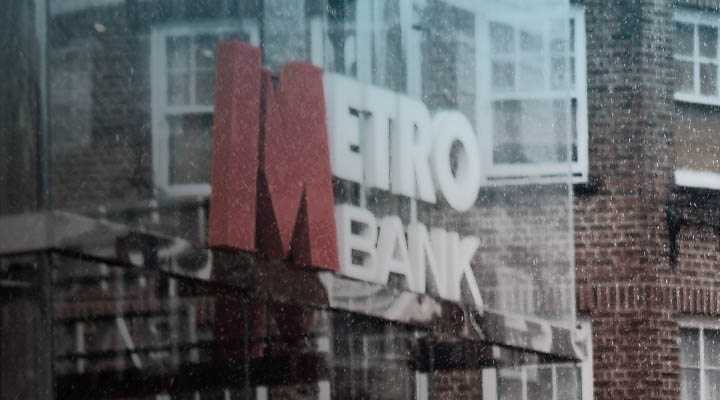Launched in 2010 to shake up the high street banking market, Metro Bank was the first bank to get licensed in the UK for over 100 years. The challenger bank’s business model was built on high-quality human customer service delivered through its branch network. Metro Bank has enjoyed relative success over the past decade, establishing itself as a top 10 bank with nearly 3 million customers.
But the past few years have been far from plain sailing for Metro. The accounting scandal in 2019 rocked the challenger bank and initiated the downwards trajectory of investor confidence. Metro’s share price has lost a staggering 98% of its value since listing in 2016 and hit an all-time low last Thursday.
Last week rumours of a potential crisis swirled as it was leaked that Metro needed to raise cash to shore up its balance sheet. The Prudential Regulation Authority (PRA) then contacted major lenders to discuss a potential sale, indicating there was concern over Metro’s financial health. News of a deal struck over the weekend to secure a £925 million rescue package was much welcomed and brought to an end a tumultuous period for the bank.
While the possibility of a deposit run and subsequent failure now seems very unlikely, question marks will remain over how Metro found itself in such a precarious position - and furthermore over the long-term viability of its expensive branch-based business model.
Investment Funding Rescues Metro Bank From Crisis
On Monday morning it was reported that Metro Bank had secured funding over the weekend, signalling the end of a chaotic week for the challenger lender.
- Metro Bank struck a £925 million deal with investors to shore up its finances, composed of £325m in new funding, as well as refinancing £600m of debt.
- Colombian billionaire Jaime Gilinski Bacal will become the majority shareholder after agreeing to contribute the lion’s share (£102 million) of the fresh equity.
- Metro Bank shares jumped 20% on Monday morning as news of the deal broke but are still down some 60% this year.
Why Did Metro Bank Need To Bolster Its Balance Sheet?
Metro Bank was in the news for the wrong reasons last week as a leak emerged that the challenger lender was seeking to raise funds to shore up its balance sheet.
- News broke Metro Bank wanted £600 million from investors to strengthen capital levels.
- It was also reported Metro was exploring selling off 1/3 - or £2.3 billion – of its mortgage book to rival lenders.
- Fears over the financial health of Metro Bank spooked investors and its shares slumped to a record low on Thursday, signalling a 99% drop from its 2018 peak.
- The PRA contacted large UK banks to gauge interest in acquiring Metro Bank last week, according to the Financial Times - but there was zero appetite among major lenders for a full takeover without sweeteners.
- Metro Bank was at pains to reassure investors and customers that its finances were healthy and that it was within regulatory requirements.
- Yet the proposed capital raise had some degree of urgency given that a £350 million portion of its debt required refinancing at some point between early next year and October 2025, meaning investors would need to put up the cash for this.
Why did Metro Bank need to raise cash?
Metro Bank had reached the edge of its capital requirements which stymied future growth prospects as it wouldn’t be able to lend.
- Metro Bank failed to convince regulators it could be trusted to use its own internal models and change the way it calculated the capital requirements on its mortgage book.
- The request was denied in September for 2023 after a multi-year campaign which led to a sell-off over the last few weeks with shares falling 60%.
- This led Metro Bank down the path to raising funding as without capital relief, until at least 2024, it could not lend without falling below minimum capital requirements, nor refinance its debt.
But capital requirements constraints aren’t the only issue facing Metro as both risk management failings and a costly business model brought scrutiny on the challenger bank.
Metro Bank fined twice by UK regulators due to reporting failings, most notably with the 2019 accounting scandal.
- Metro was fined £5.4 million by the PRA in 2021 for regulatory reporting governance and controls failings.
- Metro’s share price collapsed, and it led to a series of senior resignations due to the regulatory reporting governance and control failings findings.
- In 2022, Metro Bank was again fined – this time for £10 million – by the Financial Conduct Authority (FCA) for misleading investors with incorrect information.
Metro Bank swims against the tide by maintaining its bricks and mortar strategy.
- The high-touch branch customer service model was a hit when Metro Bank was first launched in 2010 with perks such as Sunday hours.
- Yet Metro Bank’s business model is costly for the size of its balance sheet due to its expensive physical branch network creating a high cost-to-income ratio and limiting the bank’s profitability prospects.
- Metro Bank has a much higher cost-to-income ratio than its UK high street banking peers: The Big Four’s average for 2022 was 1% v. Metro’s 106%.
- Metro Bank has only achieved full-year profitability twice in its history.
- The shift towards digital banking has accelerated over the last few years as global lockdowns during the pandemic period forced customers online.
- The emergence of digital challenger banks also helped accelerate this trend - and their rapid customer growth illustrates customer preferences are shifting away from branch-first banking.
- Major incumbent banks have responded to shifting customer demands by shuttering their physical branch network.
- Metro Bank’s co-founder and former chairman Anthony Thomson labelled Metro’s branch-first strategy as “flawed” and gave it a “very limited future.”
What’s next for Metro Bank?
- Metro Bank appeared bullish after securing fresh funding and talked up how the capital will unlock future growth through the provision of specialist mortgages and other lending.
- It is also set to roll out a cost cutting drive as part of the deal which should be in the region of £30 million per year from 2025.
- Metro Bank also said it was still in discussions about raising cash by selling up to £3 billion of its residential mortgages.
- Metro Bank remains adamant that its branch-based model is the right one with Chief Executive Officer Dan Frumkin defiantly stating, “it has a huge potential to deliver for all stakeholders,” on a call to analysts on Monday.
The funding from investors was a much-needed boost for Metro. But how did Metro Bank get into the position of needing to raise cash to bolster its balance sheet after reporting its first half-year profit since 2019 in for H1 2023? And why have its shares nosedived over the past five years?
Lessons banks can learn from the metro bank crisis
Metro Bank’s recent troubles underline the importance of sound risk management and operational resilience.
- The current turbulent economic environment makes it crucial for banks to avoid a loss of investor and customer confidence as sliding share prices can induce a deposit flight.
- And poor risk management can erode trust, evidenced by the Credit Suisse debacle and the Silicon Valley Bank failure.
- The two fines imposed by UK regulators in recent years damaged investor confidence in Metro Bank.
- Metro Bank itself said that customers have started to withdraw funds over the past weekend in response to the negative headlines.
- Banks and financial services firms must prioritise enhancing their risk management function and operational resilience.
- There is greater regulatory scrutiny on digital operational resilience through new requirements under the UK’s Operational Resilience rules and the EU’s DORA Act.
Learn more why risk management is more important than ever – and how financial services firms can enhance their risk management function in our blog ‘Why Risk Management is More Important than Ever: What FS Firms Can Learn from Credit Suisse Crisis’.
Metro Bank’s high cost to-income ratio also surfaces the value of putting in place a hybrid customer servicing model.
- Hybrid customer service will enable banks to maintain high levels of customer support while also optimising costs.
- It is now paramount that banks offer their customers strong digital options: Over 80% of UK adults say that the quality of digital experience determines who they bank with.
- That is not to say that banks should jettison their physical branches entirely as customers still show an appetite for human interactions in certain instances.
- Most of all, banking customers want a blend of physical and digital channels tailored to their preferences, depending on the product or service.
- Hybrid options adds convenience to the customer experience by enabling customers to self-serve where appetite is high and access human employees via physical branches or via their mobile app where desired.
- Tasks such as customer onboarding and answering customer queries can be automated, enabling banks to make cost savings by consolidating their physical branch network.
- AI-powered chatbots can answer customer queries more quickly and on-demand and refer more complex issues to human employees.
- The option to schedule appointments via video or in-branch will allow customers to get specialist and personalised advice on loan options or wealth management, for example.
Learn more about hybrid customer servicing and the related opportunities for financial services firms in our white paper ‘Top Financial Services Trends in 2023: Blended Customer Servicing Becomes the Expectation’.
How can BJSS help?
We have deep expertise of working with financial services firms to manage risk and advise on regulatory requirements. Our recent experience includes:
- Design and build of a reporting solution to meet EU Markets in Financial Instruments Directive II (MiFID II) reporting deadlines for a global trading venue. We also introduced a trading control framework to detect rules violations and enhanced automated testing.
- Helping a global exchange combat market abuse with big data, improving compliance, and control.
- Defining a path to enhanced operational resilience and disaster recovery for a commercial bank.
We have worked with the world’s leading financial services organisations to deliver hybrid, omnichannel customer experiences. Combining extensive technological expertise and human-centred design, our work includes:
- The rapid service design of a wealth robo-advisor for a leading investment manager.
- Overseen the re-platforming of a global retail bank’s mortgage application.
- Enabled leading UK retail bank to lead the way in Open Banking.
Want to know more?
We regularly hold sessions with financial services leaders on the best way to leverage digital solutions to achieve faster sales and profit growth. Get in touch if you’d like to know more about risk management, hybrid customer servicing, or our other areas of expertise in financial services. You can also click here to learn more about our work.
Published
April 29, 2024Reading time
6 minutesRelated posts





